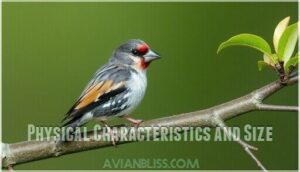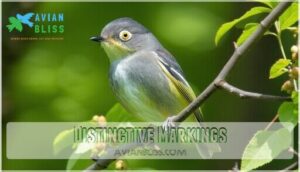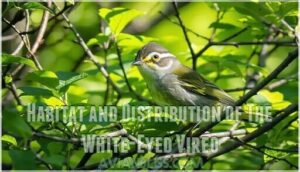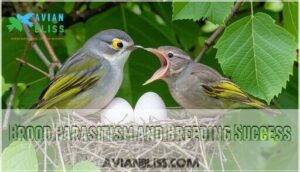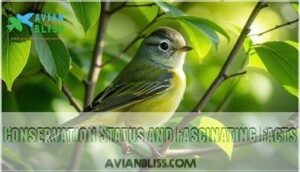This site is supported by our readers. We may earn a commission, at no cost to you, if you purchase through links.

If you hear a jumble of bold, sharp notes from tangled undergrowth, you’ve likely found one. The white eyed vireo loves scrubby edges, overgrown pastures, and even Florida’s mangroves. It sings with flair and nests with care, making it a favorite for birders—and a prime candidate for your next backyard discovery.
Table Of Contents
- Key Takeaways
- White-Eyed Vireo Identification Guide
- Habitat and Distribution of The White-Eyed Vireo
- Behavior and Vocalizations
- Breeding, Nesting, and Reproduction
- Conservation Status and Fascinating Facts
- Frequently Asked Questions (FAQs)
- Are white-eyed vireos rare?
- Where do white-eyed vireos live?
- How can I attract White-eyed Vireos to my backyard?
- What are common predators of the White-eyed Vireo?
- Can White-eyed Vireos be kept as pets in captivity?
- What role do White-eyed Vireos play in their ecosystems?
- What attracts White-eyed Vireos to backyard gardens?
- How can I photograph a White-eyed Vireo successfully?
- What is the White-eyed Vireo’s main predator?
- Are White-eyed Vireos affected by climate change?
- Conclusion
Key Takeaways
- You’ll spot the white-eyed vireo by its bright white eyes ringed in yellow, along with olive-green feathers and yellow sides.
- They favor dense shrubs, overgrown thickets, and forest edges, so check these habitats if you want to find one.
- Their bold, jumbled songs and quick, hopping movements through brush make them easy to hear even if they’re tough to see.
- These birds help control insect populations and spread seeds, quietly playing a big role in keeping their ecosystem healthy.
White-Eyed Vireo Identification Guide
You’ll recognize the White-eyed Vireo by its bright white eyes surrounded by yellow "spectacles" and compact, sparrow-sized build with a thick, hooked bill.
This small songbird measures 4.3-5.1 inches long and shows gray-green upperparts with yellowish sides, making it stand out in dense shrubby habitats.
Physical Characteristics and Size
You’ll recognize this sparrow-sized songbird by its compact build and stocky vireo anatomy. White-eyed Vireos measure 4.3-5.1 inches in length with a 6.7-inch wingspan, weighing just 0.3-0.5 ounces.
Their bill morphology features a thick, straight, slightly hooked dark gray structure perfect for capturing insects. Size shape remains consistent between sexes, showing no notable size dimorphism across measurements.
Plumage and Eye Color
You’ll spot the white eyes right away – they’re the bird’s calling card. Adults develop these striking white eyes during their second year through the molting process. Juveniles start with gray eyes that transform as they mature.
The bright plumage features an olive-green back paired with yellowish sides and white underparts. This color pattern creates natural spectacles around those famous white eyes, making identification straightforward even for beginning birders.
Distinctive Markings
Beyond the white eyes and bright plumage, you’ll notice these key field marks that make identification foolproof:
- Eye Spectacles – Yellow rings around white eyes create a distinctive "glasses" look
- Bill Morphology – Thick, slightly hooked dark gray bill with pale base
- Plumage Variation – Olive-gray upperparts with yellowish flanks and white throat
- Juvenile Markings – Young birds show gray eyes instead of white
- Color Pattern – Two white wingbars on darker wings complete the classic white-eyed vireo description
Similar Species Comparison
Several Vireo look-alikes can confuse birders. Yellow-throated Vireo shows bright yellow spectacles and throat, versus the White-eyed’s white throat. Blue-headed Vireo displays bold white spectacles with dark eyes, preferring mature forest canopy over dense shrubs. Bell’s Vireo lacks complete facial markings and appears grayer. Warbling Vireo shows no wingbars and plain faces.
Distinguishing features include eye color, habitat overlap, and behavior differences when comparing with similar species during bird identification of Vireo griseus. They’re often found in leafy eastern forests.
Habitat and Distribution of The White-Eyed Vireo
You’ll find White-eyed Vireos in dense, scrubby habitats across the eastern and central United States, plus northeastern Mexico.
These small songbirds prefer thick undergrowth, shrubby thickets, wood edges, and overgrown areas where they can forage and nest safely.
Preferred Habitats and Vegetation
You’ll find White-eyed Vireos thriving in dense scrubland ecology and thick undergrowth density. These birds prefer forest edges, riparian zones, and mangrove habitats in Florida.
Their whiteeyed vireo habitat includes overgrown pastures, deciduous scrub, and brushy areas. The bird habitat they choose offers plenty of cover—shrubby thickets, young saplings, and vegetation-rich environments where they can forage safely while staying hidden from predators.
Geographic Range and Subspecies
You’ll find Vireo griseus across the southeastern United States, with six distinct subspecies showing fascinating habitat specificity. The nominate subspecies covers most of the North American range, while V. g. maynardi inhabits the Florida Keys exclusively. Southern Texas hosts the smaller V. g. micrus, and Bermuda harbors its endemic Bermudan Vireo (V. g. bermudianus).
These subspecies variation patterns reflect migration routes and range expansion over time, creating unique distribution pockets throughout their habitat range. These birds play a role in seed dispersal within their ecosystems.
Urban and Rural Presence
You’ll discover White-eyed Vireos showing notable habitat adaptation in both urban and rural settings. These city vireos thrive in suburban areas, parks, and gardens where dense vegetation provides cover.
Rural populations prefer overgrown pastures and forest edges. Their vireo resilience helps them handle human impact while maintaining their preference for thick, scrubby habitat throughout diverse landscapes.
Seasonal Migration Patterns
White-eyed Vireos follow predictable migration patterns driven by specific migration triggers like temperature changes and daylight hours. During breeding season, they occupy eastern U.S. territories before moving south along established flyway routes.
Winter finds them in their wintering range across southern states, Mexico, and Central America. Stopover ecology plays a vital role as birds rest at coastal sites.
Climate impacts are shifting traditional wintering habitats and migration timing patterns.
Behavior and Vocalizations
You’ll notice the White-eyed Vireo moves with short, quick hops through dense brush and often sings sharp, complex patterns to mark its territory.
Study its calls and foraging behavior to better identify this secretive species in the field.
Foraging and Feeding Habits
With a knack for darting through dense shrubs, you’re most likely to spot this bird as it hops and flits about. The foraging behavior centers on Prey Capture—mostly insects are snatched mid-air or picked from foliage.
Come fall, their diet composition shifts: berries and seeds join insects, rounding out a varied Bird Diet that adapts seasonally.
Song Patterns and Call Types
When you’re out listening for birds, pay attention to the White-eyed Vireo’s unique vocalizations. Their song complexity stands out thanks to:
- A broad call repertoire
- Regional dialects that shift from place to place
- Song functions, like defending territory or attracting mates
- Vocal mimicry, as they’ll cleverly borrow from neighboring species
You’ll pick up melodious song surprises everywhere.
Territorial and Social Behaviors
Once you’ve tuned into song patterns, you’ll notice a White-eyed Vireo’s vocalization often marks the edge of its nesting territory. These birds use energetic Territory Defense and display strict Social Hierarchy. You might see Mating Rituals play out, hints of Cooperative Breeding in action, and even Winter Flocking behaviors—all unique sides of their fascinating bird behavior.
| Behavior | Notable Traits |
|---|---|
| Territory Defense | Aggressive displays |
| Social Hierarchy | Dominant males lead |
| Mating Rituals | Vocal, visual displays |
| Cooperative Breeding | Shared nest duties |
| Winter Flocking | Mixed-species groups |
Seasonal Activity Changes
During winter, you’ll spot these tiny birds switching gears. They shift territory boundaries, adapt to changes in the winter diet, and start molting.
Come breeding season, their behaviors ramp up due to migration triggers and climate change. Watch for:
- bold foraging patterns
- territory changes
- altered molting patterns
- varied breeding seasonality
It’s nature’s real-time strategy game.
Breeding, Nesting, and Reproduction
You’ll observe how the White-eyed Vireo selects dense shrubs for nesting and builds a cup-shaped nest from local materials.
Incubation, egg-laying, and all parental duties show their species’ dedication to successful broods.
Nest Site Selection and Construction
Moving from song to structure, you’ll spot the White-eyed Vireo’s nesting behavior in dense shrubs. Their nest site selection shows site fidelity, as pairs may reuse favorite areas. Nests are cup-shaped, built with spider silk, bark, and grasses. Both parents pitch in, while nest defense skills keep threats at bay.
Egg-Laying and Incubation Details
After nest building, you’ll spot the female laying Eggs—one daily until the Clutch size hits three to five. Egg Composition features white shells with reddish spots.
Both parents share the Incubation period, maintaining steady Incubation Temperature. Expect Hatching Success in about 14 days.
Timely Parental Care during Nestling Development boosts breeding season outcomes, keeping the young safe until hatching.
Parental Roles and Fledging
Once incubation duties wrap up, both parents jump into nestling care. You’ll spot them feeding the chicks with insects and keeping a sharp watch for intruders—parental defense is no joke here.
As nestlings grow into young fledglings, adults stick close, offering post-fledging support. Their teamwork ensures higher fledgling survival and sets up the next breed for success.
Brood Parasitism and Breeding Success
Your work raising nestlings faces a big disruptor: the cowbird. This brood parasite lays eggs in vireo nests, so you might find yourself feeding a fast-growing imposter.
Vireo defenses, like early nest building and re-nesting, help but only so much. Nesting success often dips when cowbird impact peaks, despite high parental investment and evolving survival strategies each breeding season.
Conservation Status and Fascinating Facts
You’ll see just how resilient the White-eyed Vireo is, as it faces unique threats like habitat loss and low nesting sites.
Watch for its quirky habits and record-setting traits that highlight the species’ adaptability for survival.
Population Trends and Threats
Scan the treetops and you’ll see that while the global population estimate for White-eyed Vireo hovers around 21 million, these songbirds still face big threats.
Habitat fragmentation and pesticide impact chip away at their homes. Climate change stirs the pot too, shifting breeding success and migration.
Tracking trends and conservation strategies through monitoring programs helps address ongoing threats and conservation needs.
Conservation Efforts and Initiatives
After looking at threats and conservation, let’s focus on what’s being done. Conservation efforts for the White-eyed Vireo include:
- Habitat Preservation projects for dense shrubland.
- Reducing Threats like window collisions and outdoor cats.
- Population Monitoring with citizen science.
- Public Awareness boosting bird conservation habits.
- Funding Allocation for habitat protection and maintaining bird populations.
Longevity and Unique Behaviors
Now that you know about conservation efforts, let’s explore some Vireo griseus behavior highlights. This species impresses with a maximum lifespan of nearly 11 years. You’ll find their unusual bathing habits—rubbing against wet leaves—fascinating. Particularly, only males sing during breeding, but both sexes join wintering songs, showcasing vocal learning. Their feeding behavior and diverse bird behavior stand out.
| Behavior | Description |
|---|---|
| Bathing | Rubbing wet foliage |
| Maximum Lifespan | Nearly 11 years |
| Song | Breeding vs. winter variation |
| Vocal Learning | Both sexes sing in winter |
Fun Facts and Record Holders
A sense of curiosity surrounds the White-eyed Vireo’s quirky ways.
- Its Vireo bathing habits include rubbing against wet leaves—not the usual splash.
- The oldest vireo record is nearly eleven years old, showing impressive lifespan.
- Only males sing on breeding grounds, but both vireo sexes belt out songs in winter, a hallmark Bird behavior.
Frequently Asked Questions (FAQs)
Are white-eyed vireos rare?
You won’t find white-eyed vireos on the rare bird alert. They’re fairly common in the Southeast, thriving in dense shrubs and thickets.
If you’re out birding, their sharp song and bright eyes are hard to miss.
Where do white-eyed vireos live?
You probably won’t spot these habitat snobs just anywhere—they’re homebodies in dense shrubs, thickets, or young forests across the southeastern U.S. and parts of northeastern Mexico.
They especially love tangled undergrowth for cover and nesting.
How can I attract White-eyed Vireos to my backyard?
Set up dense native shrubs in your garden, leaving plenty of tangled branches for cover. Add leaf litter and water features. Skip the pesticides—insects fuel their diet.
With patience, those vibrant spectacles will appear.
What are common predators of the White-eyed Vireo?
You’ll need to watch out for snakes, jays, raccoons, and even outdoor cats. These crafty predators target nests low in thick shrubs, so the vireo’s camouflaged eggs and chicks are always on someone’s menu.
Can White-eyed Vireos be kept as pets in captivity?
Like trying to put the wind in your pocket, you can’t keep these birds as pets. Wild White-eyed Vireos need thick cover, a varied insect diet, and freedom—conditions captivity just can’t replicate.
What role do White-eyed Vireos play in their ecosystems?
You’ll spot these little guys zipping through thickets, snacking on insects and spreading seeds. By controlling bug populations and helping plants grow, they act like quiet stewards, keeping their patch of wilderness in harmony.
What attracts White-eyed Vireos to backyard gardens?
Dense shrubs, native undergrowth, and berry-producing plants lure these small songbirds into your garden.
Insects hidden among tanglewood serve as a buffet, while low branches supply safe nesting and a stage for their springtime melodies.
How can I photograph a White-eyed Vireo successfully?
Patience pays off—wait quietly by dense undergrowth or tangled shrubs with your camera ready.
Early morning’s golden light helps capture plumage detail. Use a long lens, stay low and still, and let curiosity draw them near.
What is the White-eyed Vireo’s main predator?
You’ll find the main predator is often the domestic cat, lurking near nests for an easy meal.
Snakes and certain birds, like jays, also go after eggs or nestlings when given the chance.
Are White-eyed Vireos affected by climate change?
You’ll notice shifts in breeding range and timing with warmer, drier seasons. Adapting isn’t easy when climate patterns change so quickly.
As habitats shrink or shift, you might see fewer birds in old haunts.
Conclusion
Scan bramble thickets, listen for complex calls, and watch for that flash of yellow and a striking white eye—these are your clues to spotting the white eyed vireo. Knowing its habitat, song, and field marks will sharpen your ability to locate this species.
Whether you’re walking a rural lane or surveying a city park, the white eyed vireo rewards patient, careful observation. Remember these details, and you’ll build confidence as a skilled and informed birder.
- https://en.wikipedia.org/wiki/White-eyed_vireo
- https://abcbirds.org/bird/white-eyed-vireo/
- https://www.massaudubon.org/our-work/birds-wildlife/bird-conservation-research/breeding-bird-atlases/find-a-bird?id=3940
- https://txtbba.tamu.edu/species-accounts/white-eyed-vireo/
- https://www.tn.gov/twra/wildlife/birds/forest-birds/white-eyed-vireo.html

